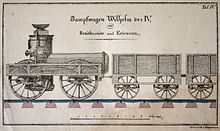John Braithwaite (engineer)
John Braithwaite the Younger (born March 19, 1797 in London ; † September 25, 1870 there ) was an English engineer and inventor of the first steam-powered fire engine .


Braithwaite was the third son of John Braithwaite the Elder. Born on 1 Bath Place, New Road, London on 19 March 1797, he worked for his school education in the factory of his father, where he further formed as a technical engineer and a gifted draftsman was. In June 1818 his father died and left the factory to the brothers Francis and John. Francis died in 1823, after which John Braithwaite ran the business alone. In 1817 he reported the steamboat explosion in Norwich to the House of Commons , and in 1820 he took care of the House of Lordsfor air pump assisted ventilation. In 1822 he built the "donkey engine" (a steam powered winch), and in 1823 he cast Sebastian Gahagan's statue of the Duke of Kent , which was erected on Portland Place in London.
He was introduced to George and Robert Stephenson in 1827 and met Captain John Ericsson around the same time . In 1829 Braithwaite and Ericsson designed the locomotive The Novelty for the Rainhill race . This steam locomotive was the first to cover a mile in under a minute (56 seconds to be precise).
Fire engines

At this time Braithwaite developed the first usable steam powered fire engine , which was ultimately destroyed by a London mob . However, it had previously served well in the fire of the English Opera House in 1830, the fire in the Argyle Rooms (also in 1830) and the major fire in the Palace of Westminster in 1834. The pump had a capacity of two tons of water per minute fired with coke and was up to working temperature within 20 minutes; However, the machine evoked so much envy among the fire departments of the time that the inventor had to give up. Soon after, however, he built four more pumps with larger dimensions, two of which (in Berlin and Liverpool ) worked very well. In 1833, John Braithwaite and Captain Ericsson built a caloric engine (a type of Stirling engine ).
Civil engineer
In the following year he ended his active participation in the management of engine development in New Road. Instead, he worked as a civil engineer for public contracts and was just called in on the skills and possible improvements of locomotive engines. In 1834 he designed and planned the Eastern Counties railway line together with Charles Blacker Vignoles . The railroad company was founded in 1836 and John Braithwaite became the chief civil engineer for the construction of this railway line shortly after it was founded . He decided on a 5-foot gauge , and this was the width of the line as far as Colchester ; however, the sleepers were designed for a track width of up to 7 feet. Following Robert Stephenson's advice , the track width was subsequently reduced to the national width of 4 feet 8½ inches. In later years Braithwaite advocated an even narrower track width.
On May 28, he ended his official connection with the Eastern Counties Railway . While working as an engineer in this company, he introduced American excavators and American steam-powered pile drivers to railroad construction . He co-founded the Railway Times, which he published in collaboration with JC Robertson as editor in 1837, and remained a sole proprietor until 1845. He began planning the direct rail line to Exeter , but the railroad craze of his day and its association with commercial speculation forced him to wind up in 1845.
Expert advisor
Braithwaite owned a patent for the extraction of oil from oil shale in 1844 , and works were built near Weymouth which, had he not got into trouble, would be very promising. A few years earlier, 1836-1838, he and Captain Ericsson had equipped a normal canal boat with a screw drive, which drove from London via the canals to Manchester and then via Oxford and the Thames back to London. It was the first and only steamboat that had made the whole distance on these waters. The experiment was stopped because there was a lack of water in the canals and because the completion of the railway lines caused paying customers to withdraw.
In 1844 and 1846 John Braithwaite spent a lot of time on the continent and surveyed railway lines in France . On his return in 1850 he was hired to survey Langston Harbor and build the Brentford Brewery (1851). From then on he was mainly occupied with office work and worked as a specialist advisor on current mechanical issues, including patents.
Honors
Braithwaite became a member of the Society of Antiquaries in 1819 , joining the Institution of Civil Engineers on February 13, 1838. At the time of his death, he was one of the oldest members of the Royal Society of Arts , into which he had been inducted in 1918. He was also president of 17 charitable institutions.
He died very suddenly on September 25, 1870 at 8 Clifton Gardens, Paddington , and was buried in Kensal Green Cemetery.
Publications
- Supplement to Captain Sir John Ross's Narrative of a second voyage in search of a North-West Passage, containing the suppressed facts necessary to an understanding of the cause of the failure of the steam machinery of the Victory 1835. On this work Sir J. Ross got another answer in the same year
- Guideway Steam Agriculture, by PA Halkett, with a Report by J. Braithwaite 1857
Web links
| personal data | |
|---|---|
| SURNAME | Braithwaite, John |
| BRIEF DESCRIPTION | English engineer and inventor |
| DATE OF BIRTH | March 19, 1797 |
| PLACE OF BIRTH | London |
| DATE OF DEATH | September 25, 1870 |
| Place of death | London |

